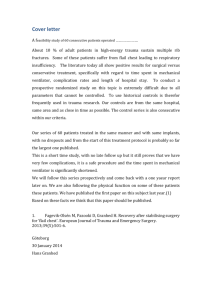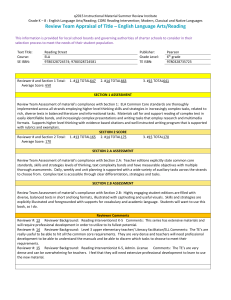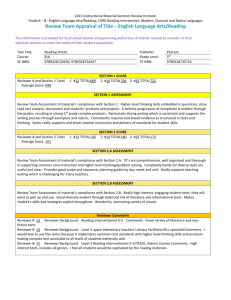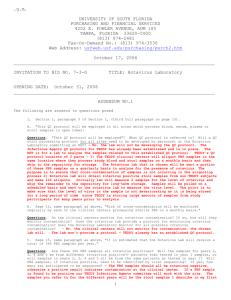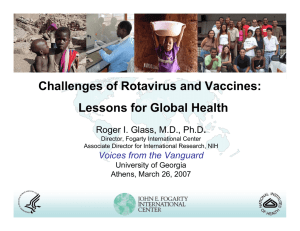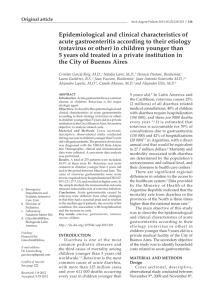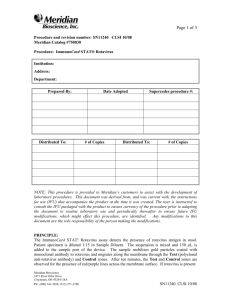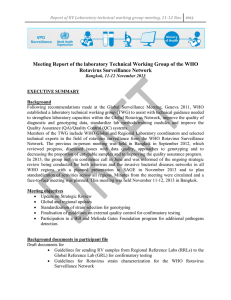Mark J - BioMed Central
advertisement
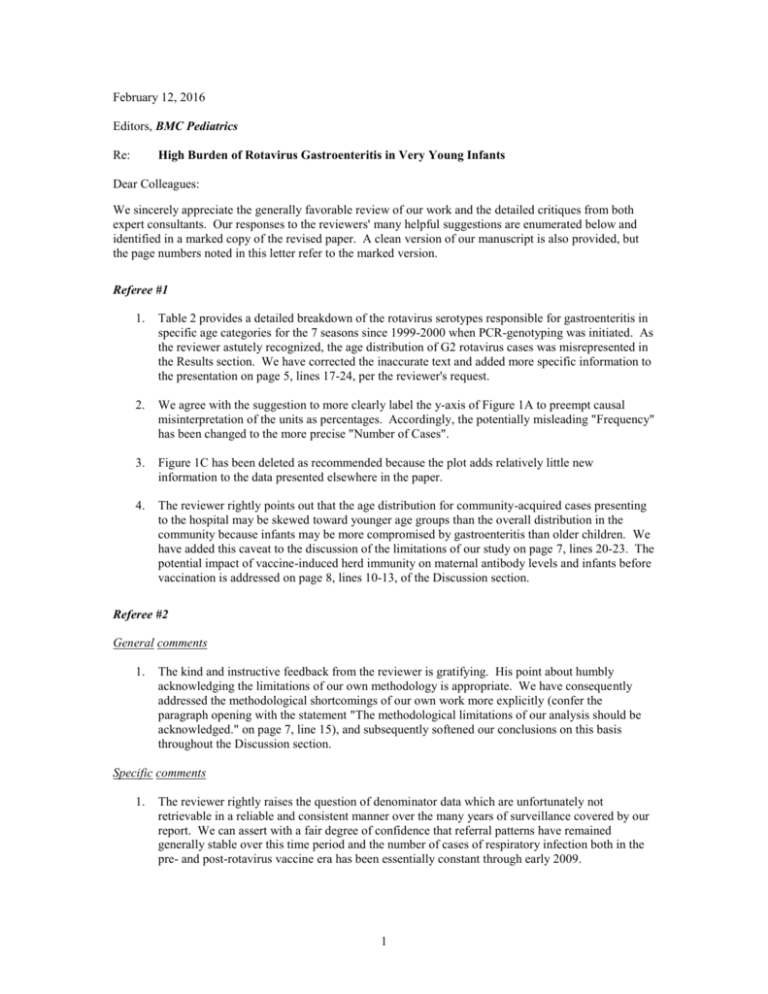
February 12, 2016 Editors, BMC Pediatrics Re: High Burden of Rotavirus Gastroenteritis in Very Young Infants Dear Colleagues: We sincerely appreciate the generally favorable review of our work and the detailed critiques from both expert consultants. Our responses to the reviewers' many helpful suggestions are enumerated below and identified in a marked copy of the revised paper. A clean version of our manuscript is also provided, but the page numbers noted in this letter refer to the marked version. Referee #1 1. Table 2 provides a detailed breakdown of the rotavirus serotypes responsible for gastroenteritis in specific age categories for the 7 seasons since 1999-2000 when PCR-genotyping was initiated. As the reviewer astutely recognized, the age distribution of G2 rotavirus cases was misrepresented in the Results section. We have corrected the inaccurate text and added more specific information to the presentation on page 5, lines 17-24, per the reviewer's request. 2. We agree with the suggestion to more clearly label the y-axis of Figure 1A to preempt causal misinterpretation of the units as percentages. Accordingly, the potentially misleading "Frequency" has been changed to the more precise "Number of Cases". 3. Figure 1C has been deleted as recommended because the plot adds relatively little new information to the data presented elsewhere in the paper. 4. The reviewer rightly points out that the age distribution for community-acquired cases presenting to the hospital may be skewed toward younger age groups than the overall distribution in the community because infants may be more compromised by gastroenteritis than older children. We have added this caveat to the discussion of the limitations of our study on page 7, lines 20-23. The potential impact of vaccine-induced herd immunity on maternal antibody levels and infants before vaccination is addressed on page 8, lines 10-13, of the Discussion section. Referee #2 General comments 1. The kind and instructive feedback from the reviewer is gratifying. His point about humbly acknowledging the limitations of our own methodology is appropriate. We have consequently addressed the methodological shortcomings of our own work more explicitly (confer the paragraph opening with the statement "The methodological limitations of our analysis should be acknowledged." on page 7, line 15), and subsequently softened our conclusions on this basis throughout the Discussion section. Specific comments 1. The reviewer rightly raises the question of denominator data which are unfortunately not retrievable in a reliable and consistent manner over the many years of surveillance covered by our report. We can assert with a fair degree of confidence that referral patterns have remained generally stable over this time period and the number of cases of respiratory infection both in the pre- and post-rotavirus vaccine era has been essentially constant through early 2009. 1 2. Since we highlight the number of cases diagnosed during the first few month of life in the Results section of the Abstract, we have better defined "very young infants" by rephrasing as "infants <3 months old" on page 2, lines 20-21, in the Conclusions of the Abstract. 3. Although we concur with the reviewer about the value of these additional data, the information is not obtainable from the available records, as noted in our first response immediately above in this section. Although not even semi-quantitative, our impression is that the number of children presenting with winter gastroenteritis (and respiratory infections) had not dramatically changed during the period of surveillance prior to introduction of the rotavirus vaccines. 4. The "non-white" category potentially includes children of African, Asian, Hispanic, Eskimo, and Native American heritage. This explanation has been added to Table 1 (which reports the demographic characteristics of the patients included in our analysis) on page 17 as a footnote. The neighborhoods surrounding CHOP in West Philadelphia are ethnically diverse but predominantly African-American. 5. Any patient presenting to CHOP with gastroenteritis was eligible for inclusion, as now noted on page 3, line 24, of the Methods section. The actual age breakdown for patients included in the analysis (including the full range of ages) is summarized on page 5, lines 9-16, where the prevaccine and post-vaccine eras are compared. This information is reiterated in more detail in the legend for Figure 1B on page 19. The maximum age of an outlier patient in the analysis was 20 years ("240 months"), whereas the median age [IQR] was 11 [5-21] months. So more than 75% of the patients were under 2 years of age. The intended purpose of the old Figure 1C (now deleted at the behest of Referee 1) was to display the entire age distribution; we would gladly reinsert this figure at your discretion. 6. We agree with the reviewer's emphasis on children <3 months of age who would receive little direct benefit from a vaccination schedule commencing at 8-12 weeks of life, although they might be protected to some degree by herd immunity. These points have been incorporated in the Discussion section on page 8, lines 10-15 and 17-19. 7. The problematic wording has been modified to read "the proportion of patients with reovirus identified in their stool samples" instead of "the relative risk of identifying reovirus in stool" on page 7, lines 2-3, to satisfy the concern voiced by the reviewer. 8. As advised, we now indicate that the first dose of rotavirus vaccine usually administered at ~2 months of age may afford significant protection within a few weeks of receipt as a bridge to subsequent doses on page 8, lines 13-15. 9. The cost:benefit ratio for neonatal vaccination against rotavirus will depend on several unknown factors, including (but not limited to) the degree of herd immunity and its effects on maternal antibodies. These important issues are now acknowledged and addressed on page 8, lines 10-19. 10. The possible implications of vaccine-induced herd immunity are considered on page 8, lines 1013. 11. The durability of vaccine-elicited immunity has not yet been precisely established, but preliminary data suggest substantial protection will endure for >3 years after completion of the full series of the monovalent (RV1) or pentavalent (RV5) vaccines. Recommendations about booster doses in older children seem premature at this point given the current state of our knowledge and persistent concerns about vaccine-associated intussusception in children beyond 8 months of age, and are tangential to the main thrust of this report. 12. Our conclusion has been qualified as proposed by the reviewer in both lines 1 and 19 on page 8. We trust that attention to the consultant's insightful and informative criticisms as translated into our revised manuscript have strengthened our presentation. 2 Editorial matters 1. The Disclosures page has been replaced by a 'Competing Interests' section on page 9. 2. A new section describing Authors' Contributions has been added as page 10. 3. The Abstract on page 2 has been modestly reformatted to exactly meet BMC specifications for medical articles. The word count is presently 296. All authors have made substantive contributions to the report, and have subsequently reviewed and approved an essentially final version of the revised manuscript. Merck and Co., Inc., which markets the pentavalent rotavirus vaccine (RotaTeq), supported this study in part. Disclosures regarding potential conflicts of interest are detailed in the paper itself. Thank you for your time and consideration. Your response is eagerly anticipated. Respectfully submitted, Mark J. DiNubile, M.D. 3




